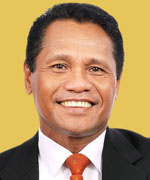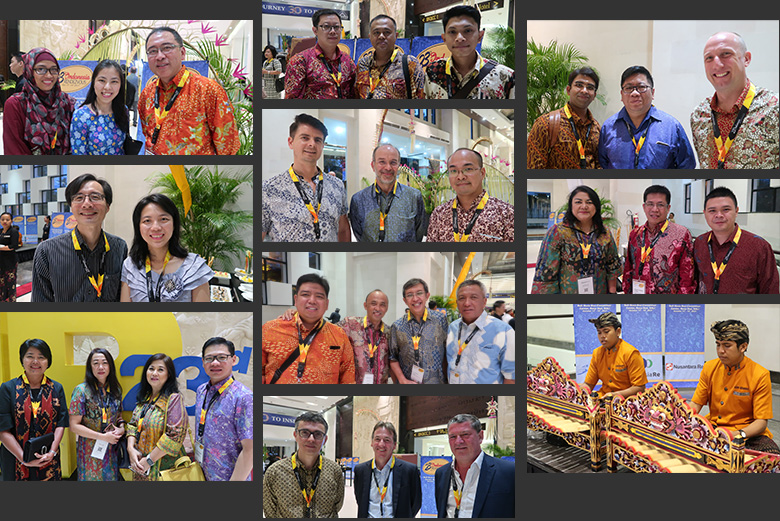Indonesia: A Force with a Growth Spirit

Indonesia, the biggest in Asean and the 16th largest market in the world with a GDP of US$933 billion, is a force of its own even in the insurance arena. And this 23rd Indonesian Rendezvous with a good pull of some 400 delegates from ten countries bear testimony to its importance.
The Rendezvous with Mt Agung on the verge of erupting and with thousands in the north of the island being evacuated, might provide an ideal setting to discuss the NAT CAT risks facing the country as well as the wide protection gap. Non-life premiums only accounts for 0.51% of the GDP and the per capita spend on general insurance is only US$18.2 with a population base of 261 million in 2016. In gross terms, Indonesia’s general insurance premium is the 38th largest in the world at US$4.740 billion in 2016 according to sigma figures.
But everyone is banking on Indonesia’s growth potential which has been coming for a long time now. There are strong promises of infrastructural developments with more towns coming up and the attending construction projects too.
In many way Indonesia was one of the early movers in liberalising the market but it has taken many turns as well. And the focus for the past two years has been back to domestic to give a chance for the local companies to beef themselves up. Though being challenged internationally as being protectionist and against the spirit of free trade, internally it has started to bear fruit. There are now more local companies with a stronger capital base too. And now all eyes are on the new national reinsurer Indonesia Re with speculations rife as to will it be old wine in a new bottle, or a true force for change in this digital era where data and analytics is everything.
At this Rendezvous, networking aside, the stress is on the theme of fighting fraud. Fraud is a huge issue for the entire global insurance industry with estimates ranging from 10 to 25% of all premiums being eroded by fraud. Will technology make insurers smart at controlling fraud or in reverse, will the IoT make the claimants more fraud savvy and milk the insurers. Will companies be ready to admit they got scammed?
But the key point is that industry must be ready to document and share data of FRAUD from suspicions to actual evidence. But will the laws allow that? Can data protection laws extend to protect policyholders who are colluding in trying their luck with getting a claim paid?
Lessons from the Indonesia Rendezvous will be needed to be shared widely to help the industry as a whole, as in many ways Indonesia is the natural leader of Asean and the Asean Economic Community.
Here’s to a great rendezvous with fruitful discussions and enduring friendships!
Risk management key amid changing insurance landscape

Indonesia is in the midst of modernising its insurance industry, which brings both opportunities and challenges to a diverse range of insurers across the country. Current market conditions and a relatively benign catastrophe loss environment presents insurers with a prime opportunity to further strengthen their capital adequacy and Enterprise Risk Management (ERM).
Total insured property and engineering exposures have increased at a rapid pace over the last seven years in line with the overall growth of the Indonesian economy. Over the same period, reinsurance cessions and exposure adjusted reinsurance purchases have steadily declined and domestic reinsurers are now more exposed to large loss as a consequence. Regulatory changes since 2014 have helped to facilitate these trends.
As Indonesia’s insurance sector continues to develop, reinsurance remains a key risk mitigating strategy. As part of this holistic approach to risk management, well-structured programmes that provide risk-bearing capital at attractive costs are critical for the longer-term health of the sector. Over time, insurers with well-executed strategies will emerge in a much stronger position to underwrite, price and ultimately retain more risk prudently.
Highlights
Property and engineering exposures were significantly higher in 2016 compared to prior years on a net of reinsurance basis. This is due, in part, to recent regulatory changes requiring higher per-risk retentions for insurers and compulsory cessions to domestic reinsurers.
Exposure-adjusted premium rates have fallen over time, including reinsurance rates, with property catastrophe rates declining by up to 20% p.a.
Recent trends point to a ‘rationalisation’ of reinsurance purchasing, resulting in limits remaining static and only modest increases in retentions compared to the rapid growth in exposures.
Nevertheless, current coverage levels still appear to be adequate on a 250-year PML basis, albeit with a reduced ‘safety buffer’ in the event of non-modelled perils such as flood or other non-accounted for exposures.
Since 2014, counterparty exposures of primary insurers have also shifted towards domestic reinsurers. Given the current regulatory landscape, this is likely to persist in the short term.
The ability to write non-Indonesian business will therefore bring much needed diversification to domestic reinsurers. At the same time, increased regulatory retentions increase the need for insurers to have more sophisticated underwriting controls, ERM and capital management capabilities in place.
Given the large dependency on reinsurance as a source of risk-bearing capital, ensuring reinsurance programmes are fit–for purpose will be critical, especially in Indonesia which is heavily exposed to natural perils.
“While insurance and reinsurance premium volumes have grown in line with the market, this has not kept pace with the overall increase in exposures and risk”
Significant increase in retained exposures after 2015
While insurance and reinsurance premium volumes have grown by an average of 10% p.a. in monetary terms between 2011 and 2016 in line with the market, this has not kept pace with the overall increase in exposures and risk. In other words, exposure-adjusted premium rates have fallen over time.
This has been especially true for reinsurance rates, particularly after 2014 where the rate of increase has lagged behind primary rates. The lack of catastrophic loss activity in Indonesia in recent years is likely to be driving this continued appetite for risk and availability of reinsurance capacity.
Increased concentration in counterparty risk
While there is a general trend of increasing cession rates to domestic reinsurers, it is important to note this is not solely due to regulatory change. There are many other influencing factors such as reinsurance pricing, renewal terms and available capacity which come into play as well.
A share of the cessions to domestic reinsurers are also retroceded out to international reinsurance groups, so the true proportion of the total risks that are retained within Indonesia is lower than what can be concluded given the available data.
Overall, JLT Re believes that this pattern is likely to be similar across many of the reinsurance placements of all (or most) insurers in Indonesia, indicating an increase in concentration of risks across a smaller pool of domestic reinsurers.
Implications
The trends highlighted have implications for the risk management functions of Indonesian insurers and reinsurers. Proactive measures taken now in the areas of ERM, capital and risk management will enable organisations to differentiate themselves from their peers and reward those willing to make the investment.
ERM / Business / Capital Management
Many Indonesian insurers already employ internal ERM frameworks which encompass a range of risk mitigation efforts. However, increased dependency on a smaller pool of reinsurers highlights the need to monitor concentration risk more closely.
Increased retentions can be positive for insurers where accompanied by indepth consideration for risk tolerances, capacity optimization and underwriting discipline. JLT Re notes that this has been the approach taken recently by the Indonesian Financial Services Authority (Otoritas Jasa Keuangan or OJK). This also highlights the need for risk management strategies to consider more than reinsurance.
Catastrophe Exposure Management
The need to quantify flood exposures remains a challenge particularly with the large concentration in Jakarta. The capital is prone to regular flooding and has experienced significant economic losses in recent years, in particular, in 2013 with an insured loss of USD 250 million.
Many insurers and reinsurers make use of catastrophe vendor models to provide a view of their retained and ceded catastrophe risk, and keeping pace with current and future modelling changes will be important to supporting and improving overall ERM and accumulation control efforts.
A better industry

Pak Frans Sahusilawane, CEO of IndoRe, shares his thoughts on how the industry has changed for the better in the past year and what else it needs to do to continue improving.
How has the latest regulation on reinsurance cessions affected insurers in Indonesia?
There is a number of positive impacts, as I see it. First, the regulation requires insurers to increase their minimum per-risk retention. This resulted in a big increase in their retained premium income. Second, because of this, combined with RBC rule and the need to invest in new technology, we start to see companies increasing their capital way above the minimum requirement. I see the sign that this starts to bring about all those good things that come with the increase of internal resources in corporate’s strategy. So, a good sign for the future of the industry.
There had been a concern of possible knowledge-gap created because of reduced involvement of international reinsurers. This proved to be unfounded, as there is still an access to international market provided by the regulation.
There had also been a concern about potential ‘LMX-spiral like’ operation as recently experienced by Thai market in 2011/2012 flood. To this, I would like to say that after more than a decade of promoting catastrophe risk awareness within the industry and to public at large compounded by new knowledge flowing in the industry from various research, the knowledge and capabilities of our insurance players in catastrophe risk management has increased tremendously. I understand all our general insurance companies have their catastrophe exposure assessed by catastrophe model like RMS, AIR, Catalytics, and MAIPARK in programming their catastrophe reinsurance protection. Furthermore, I see the trend of general insurance companies reducing their involvement in uncontrollable exposure source of business such as proportional reinsurance treaties.
On life insurance side this kind of reinsurance exchange among direct insurers are second to none. After all, despite vast insurance premium produced on the life insurance side, I believe now coming up to IDR 200 trillion, the life reinsurance premiums is not big, since only mortality risks are reinsured. I believe the total life reinsurance premium this year will be around IDR 4 trillion only, and the biggest chunk of it has always been placed locally.

Fitch’s recent report on Indonesia’s Reinsurance market forecast high profits in 2017. How is Indo Re planning to take advantage of this growth, from a strategic standpoint?
We are building and enhancing our dynamic capabilities especially in three areas: financial capital, human capital, and technology. Financial capital has been taken care of by our shareholder with commitment of up to IDR 10 trillion additional capital depending on the portfolio we develop. Human capital and technology are in the pipeline of process. Apart from that with our product differentiation, especially through our unique “NES” Policy we were able to book a growth of 56% and 50% in the last two years and around 25% in the first semester this year.
The Indonesia Rendezvous will focus on fraud prevention in insurance. Are insurers doing enough to stop fraud and money-laundering? How much should the regulator get involved in this?
Insurance and reinsurance players, especially on life insurance side, are governed by a number of laws and regulations which are observed cautiously to prevent money laundering.
On insurance fraud by the insured, there have been a number of quite serious cases experienced in the Indonesian insurance market. Therefore, various measures have been on this, but they seem to be partial and uncomplete. I believe we need a much more comprehensive, wider and complete set of measures.
On prevention of fraud by insurance practitioners, all insurance and reinsurance companies and practitioners are subject to the same generic laws and regulations but you will see different set of rules apply in different group of companies. In all, if we can make comparison, our insurance industry is way behind that of the banking industry.
Welcome to the 23rd Indonesia Rendezvous
For 23 years now the Indonesia Rendezvous has been held as an annual affair, first starting out as the Batam Rendezvous before assuming its current name and location. Held in Nusa Dua district of Bali, the event has become a mainstay on the Southeast Asian insurance conference calendar for those active in the region’s largest market.
This year, the Rendezvous will be looking at fraud management as a priority – especially in the context of cyber which can be a trigger for new forms of insurance fraud.
And in the usual tradition, delegates kicked off proceedings last evening with the Welcome Cocktail and Gala Dinner. Below are some of the highlights.
